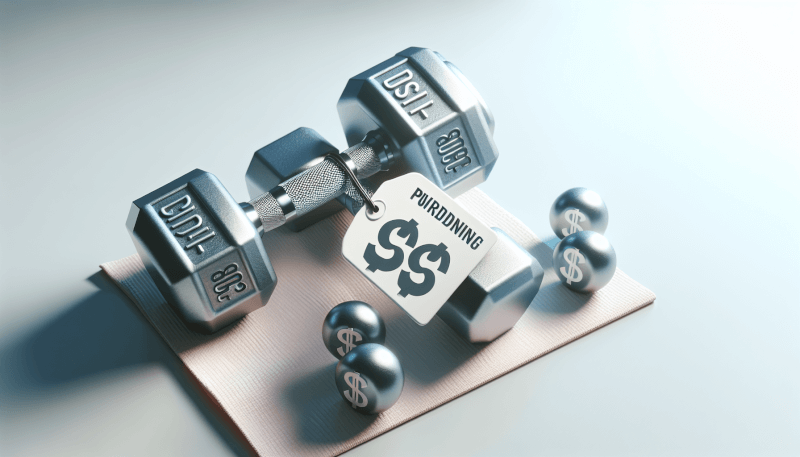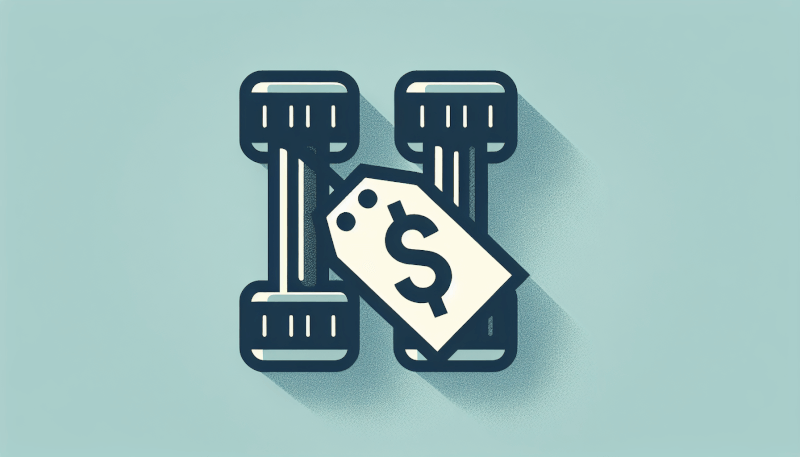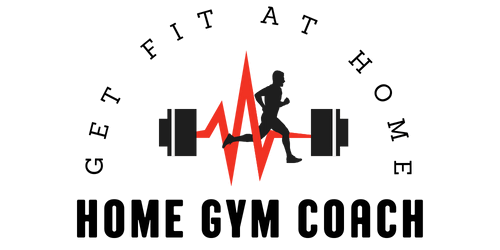Are you looking to get fit without breaking the bank? In this article, you will discover the secrets to creating an effective custom workout plan on a budget. We will explore various tips and strategies that will help you design a personalized fitness routine tailored to your goals and financial constraints. From choosing affordable equipment to utilizing free resources, you will learn how to maximize your results without emptying your wallet. Get ready to embark on a fitness journey that is both effective and economical.

Evaluate Your Fitness Goals
Assess your current fitness level
Before creating a custom workout plan, it’s important to assess your current fitness level. Take note of your strengths, weaknesses, and any injuries or limitations you may have. Consider factors such as cardiovascular endurance, muscular strength, and flexibility. This self-evaluation will help determine where you stand and what areas you need to focus on.
Define your goals
To create an effective workout plan, you need to define your fitness goals. Are you looking to lose weight, build muscle, improve endurance, or enhance overall fitness? Once you have a clear understanding of what you want to achieve, you can tailor your workouts accordingly. Setting specific, measurable, achievable, relevant, and time-bound (SMART) goals will give you direction and motivation.
Consider your budget constraints
Working out on a budget is not a problem, as there are plenty of affordable options available. Before diving into pricey gym memberships or expensive equipment, consider what you can realistically afford. Evaluate your budget and explore cost-effective alternatives such as home workouts, bodyweight exercises, or utilizing everyday objects as weights. Remember, getting fit doesn’t have to break the bank.
Research Different Training Methods
Explore bodyweight exercises
Bodyweight exercises are a great option for individuals looking to work out without any equipment. These exercises leverage your own body weight to build strength and improve muscle tone. From push-ups and squats to lunges and planks, there are countless bodyweight exercises that can be done anywhere, at any time.
Look into resistance band workouts
Resistance bands are a versatile and affordable piece of exercise equipment. They provide a convenient way to add resistance and intensity to your workouts. With different resistance levels, you can easily adjust the difficulty to suit your fitness level. Resistance band workouts target various muscle groups and can be done in the comfort of your own home.
Consider HIIT workouts
High-Intensity Interval Training (HIIT) is a popular and time-efficient training method. HIIT involves short bursts of intense exercise followed by brief recovery periods. This type of workout can be done with minimal equipment, making it perfect for those on a budget. HIIT workouts have been shown to boost metabolism, improve cardiovascular health, and burn calories effectively.
Consider using exercise apps or online workout programs
In the digital age, there are numerous exercise apps and online workout programs available. These platforms offer a wide range of workout routines, from beginner to advanced levels. Many of them provide customizable options based on your fitness goals and preferences. Explore different apps and online programs to find the one that suits you best.

Determine Frequency and Duration
Understand the recommended exercise frequency
The frequency of your workouts will depend on your fitness goals and current fitness level. Generally, it is recommended to engage in at least 150 minutes of moderate-intensity aerobic activity or 75 minutes of vigorous-intensity aerobic activity per week. This can be broken down into sessions of 30 minutes, 5 days a week. However, you may need to adjust this based on your individual needs and limitations.
Choose an appropriate workout duration
The duration of your workouts will also depend on your goals and fitness level. It’s important to find a balance between pushing yourself and avoiding overexertion. Start with shorter workouts and gradually increase the duration as your fitness improves. Listen to your body and make sure to give yourself enough time to recover between sessions.
Design Your Workouts
Warm-up exercises
Before starting any workout, it’s crucial to warm up your muscles and joints. This helps prevent injuries and prepares your body for physical activity. Incorporate dynamic stretches, such as arm circles or leg swings, to increase blood flow and mobility. Spend 5-10 minutes on a warm-up routine that targets all major muscle groups.
Cardiovascular exercises
Cardiovascular exercises, also known as cardio, are important for improving heart health and burning calories. Choose activities that elevate your heart rate and make you break a sweat. Options include jogging, cycling, dancing, swimming, or even jumping rope. Aim for at least 20-30 minutes of moderate-intensity cardio exercises, 3-5 times a week.
Strength training exercises
Strength training is crucial for building lean muscle mass, improving bone density, and increasing metabolism. Incorporate exercises that target all major muscle groups, such as squats, lunges, push-ups, and overhead presses. Start with lighter weights or bodyweight and gradually increase the resistance as you get stronger. Perform 2-3 sets of 8-12 repetitions for each exercise.
Stretching and flexibility exercises
Stretching helps improve flexibility, enhances muscle recovery, and reduces the risk of injury. Include static stretches that target the muscles you worked during your strength training or cardio session. Hold each stretch for 15-30 seconds and repeat 2-3 times on each side. Stretching can be done post-workout or on rest days to aid in muscle recovery.
Cool-down exercises
Just as warming up is important, cooling down allows your body to gradually return to its resting state. This helps reduce muscle soreness and prevent dizziness or fainting. Engage in light aerobic exercises, such as walking or slow jogging, for 5-10 minutes. Finish off with static stretches to further promote muscle recovery.

Create a Weekly Workout Schedule
Allocate time for each workout session
To ensure consistency and adherence to your workout plan, allocate specific time slots for each session. Treat your workout sessions as appointments that cannot be missed. This will help establish a routine and make it easier to stick to your plan. Consider your daily schedule and choose times that work best for you. Whether it’s early mornings, lunch breaks, or evenings, find a schedule that fits your lifestyle.
Balance between cardiovascular and strength training exercises
A well-rounded workout plan should include a balance of cardiovascular and strength training exercises. Aim to alternate between the two to give your body enough time to recover and build strength. For example, you can schedule cardio sessions on Mondays, Wednesdays, and Fridays, and strength training sessions on Tuesdays, Thursdays, and Saturdays. Listen to your body and make adjustments as needed.
Incorporate rest days
Rest days are just as important as workout days. They allow your body to recover, repair, and grow stronger. Plan at least one or two rest days per week to give your muscles and joints a chance to rest. Use these rest days to engage in light activities such as walking or stretching. Remember, overtraining can lead to injuries and burnout, so be mindful of giving yourself proper rest and recovery.
Make Use of Free or Inexpensive Exercise Equipment
Utilize everyday objects as weights
You don’t need fancy equipment to get a good workout. Everyday objects like water bottles, canned goods, or backpacks filled with books can be used as makeshift weights. Get creative and find household items that can add resistance to your strength training exercises. This way, you can still challenge and strengthen your muscles without spending extra money.
Find discounted or second-hand fitness equipment
If you prefer using actual fitness equipment, consider looking for discounted or second-hand options. Many sporting goods stores offer sales or discounts on exercise equipment, especially during certain times of the year. Additionally, check online marketplaces or local classifieds for used fitness equipment. Just make sure to inspect the items carefully before purchasing.
Look for online deals and promotions
Keep an eye out for online deals and promotions on exercise equipment. Many online retailers offer discounts or bundle deals on fitness gear. Subscribe to newsletters or follow fitness brands on social media to stay updated on any upcoming sales. By being patient and vigilant, you can find quality equipment at affordable prices.

Utilize Bodyweight and Calisthenic Exercises
Incorporate exercises like push-ups, squats, and lunges
Bodyweight exercises are an excellent way to build strength and improve overall fitness. Push-ups, squats, and lunges are staple exercises that target multiple muscle groups and require no equipment. Start with a number of repetitions that challenges you, and gradually increase as you get stronger. These exercises can be performed at home, in the park, or even during a work break.
Include planks, burpees, and mountain climbers for core strength
To strengthen your core muscles, incorporate exercises like planks, burpees, and mountain climbers. Planks engage your abdominals, back, and shoulder muscles, while burpees and mountain climbers provide a full-body workout. These exercises not only improve core stability but also help with overall body coordination and balance.
Try out variations and progressions to challenge yourself
As you become more comfortable with bodyweight exercises, don’t be afraid to try out variations and progressions. For example, you can add a clap in between push-ups or increase the range of motion in your squats and lunges. Progressing your exercises ensures that you keep challenging your muscles and continue to see improvements in strength and endurance.
Explore Online Resources and Apps
Use workout apps with pre-designed workout plans
Workout apps can be a great tool for designing your custom workout plan. Many apps offer pre-designed workout plans tailored to different fitness goals and levels. Simply input your preferences, and the app will create a plan for you. These apps often come with video demonstrations and timers to guide you through the exercises.
Follow online workout videos
Online workout videos provide a visual demonstration and guidance through various exercises. Platforms like YouTube offer a wide range of workout videos from fitness professionals and enthusiasts. You can find anything from cardio workouts to yoga routines. Pick a video that suits your interests and follow along at your own pace.
Join social media fitness communities for support and inspiration
Social media platforms like Instagram and Facebook have vibrant fitness communities that offer support, inspiration, and workout ideas. Follow fitness influencers and hashtags related to your fitness goals to discover new exercises and connect with like-minded individuals. These online communities can provide valuable tips, motivation, and accountability throughout your fitness journey.

Consider Outdoor Workouts
Take advantage of running or jogging in your neighborhood
Running or jogging in your neighborhood is a great way to get fresh air and enjoy your surroundings while working out. Lace up your shoes and explore your local streets or parks. Set a distance or time goal and gradually increase it as your fitness improves. Remember to wear comfortable shoes and stay hydrated.
Try outdoor activities like hiking, cycling, or swimming
If running isn’t your thing, try outdoor activities like hiking, cycling, or swimming. Hiking is a great way to challenge your cardiovascular system while enjoying nature. Cycling allows you to cover longer distances and explore new areas. Swimming provides a low-impact, full-body workout that is gentle on the joints. All of these activities offer an opportunity to enjoy the outdoors and keep fit at the same time.
Find free outdoor fitness classes or groups
Many communities offer free outdoor fitness classes or groups. These can include activities like yoga, boot camps, or group runs. Search online or inquire at local community centers or gyms for any available options. Exercising in a group setting can provide motivation, accountability, and opportunities to meet new people who share your fitness interests.
Seek Guidance from Professionals
Consult a fitness trainer or instructor for personalized advice
If you’re unsure about designing your own workout plan, consider consulting a fitness trainer or instructor. They can provide personalized advice based on your specific goals, fitness level, and any limitations you may have. A professional can also teach you proper form and technique to minimize the risk of injuries and maximize results.
Attend group fitness classes for expert guidance
Group fitness classes are an excellent way to receive expert guidance and motivation. Joining a class allows you to learn from experienced instructors and participate in structured workouts. Many gyms, community centers, and fitness studios offer a variety of classes, from Zumba and spin to strength training and yoga. Choose classes that align with your goals and schedule.
Join a community center or gym with professional trainers
Community centers and gyms often have professional trainers on staff. Joining such a facility gives you access to their expertise and guidance. Trainers can help design a workout plan that suits your needs and provide feedback on your progress. Additionally, these facilities often provide a variety of equipment and amenities to enhance your workout experience.
Creating an effective custom workout plan on a budget is not only possible but also highly rewarding. By evaluating your fitness goals, researching different training methods, determining frequency and duration, designing your workouts, and utilizing free or inexpensive equipment, you can embark on a fitness journey that fits your budget. With determination, consistency, and the guidance of professionals when needed, you can achieve your desired fitness level without breaking the bank. So, start today and embrace a healthier and more active lifestyle!


